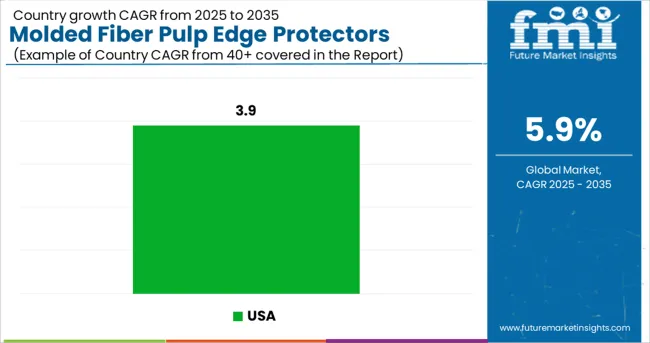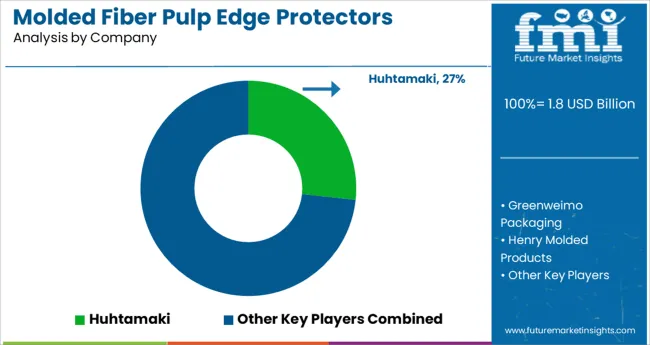The Molded Fiber Pulp Edge Protectors Market is estimated to be valued at USD 1.8 billion in 2025 and is projected to reach USD 3.2 billion by 2035, registering a compound annual growth rate (CAGR) of 5.9% over the forecast period.

The alginic acid market is undergoing consistent growth, propelled by rising demand from food processing, pharmaceutical formulations, and cosmetic applications. A growing focus on natural and sustainable ingredients in manufacturing processes has positioned alginic acid as a preferred biopolymer across industries.
The market is further supported by its diverse functional benefits, including water retention, gelling, and stabilizing properties, which make it indispensable in high-performance formulations. Increased regulatory acceptance of alginates as safe additives and the push towards cleaner labeling in food and personal care products have reinforced their adoption.
Ongoing innovation in extraction technologies and the utilization of algae as a renewable resource are paving the way for cost-effective production and expanded applications, ensuring sustained market expansion in the coming years.
The market is segmented by Pulp Type and End Use and region. By Pulp Type, the market is divided into Thick Wall, Transfer Molded, Thermoformed Fiber, and Processed Pulp. In terms of End Use, the market is classified into Electrical & Electronics, Automotive, Healthcare, Shipping & Logistics, and Other Industries. Regionally, the market is classified into North America, Latin America, Western Europe, Eastern Europe, Balkan & Baltic Countries, Russia & Belarus, Central Asia, East Asia, South Asia & Pacific, and the Middle East & Africa.
When segmented by salts, sodium alginate is expected to command 27.5% of the market revenue in 2025, marking it as the leading subsegment in this category. This leadership has been driven by its superior solubility, ease of incorporation into formulations, and versatility in a wide range of applications.
Its ability to form stable gels and maintain viscosity under varying conditions has made it highly sought after in both food and pharmaceutical sectors. Manufacturers have prioritized sodium alginate due to its consistent performance, cost-effectiveness, and regulatory acceptance, which have collectively strengthened its position.
The segment’s prominence has also been enhanced by its adaptability to evolving consumer preferences for plant-derived and sustainable ingredients, reinforcing its market share.
Segmented by end user industry, the food industry is projected to hold 33.0% of the market revenue in 2025, positioning it as the most prominent sector. This dominance has been shaped by the industry’s increasing reliance on alginic acid and its derivatives to deliver desirable textures, stabilize emulsions, and improve shelf life of processed foods.
As consumer demand for clean label and natural additives has intensified, the food sector has responded by integrating alginates into bakery, dairy, and confectionery products. Enhanced production efficiency and compliance with food safety standards have further encouraged widespread use.
The segment’s leadership has also been supported by product differentiation strategies where alginates contribute to premium quality and innovation, securing their role in modern food formulations.
The global molded fiber pulp edge protectors market has grown at a CAGR of 5.2% during the historic period with a market value of USD 1.7 Billion in 2024.
Molded Fiber Edge Protectors are made up of biodegradable materials like recycled papers, cardboard. They were having a property of shock absorption properties which ensure the protection of the products from getting damaged and are used for easy transportation, handling, and safe storage of products.
The demand for fiber pulp is expected to grow majority in the food & beverages and personal care industry as the increasing demand for eggs and trays, as this packaging solution is utilized for the packaging of eggs. Transfer molded products are used to package electrical devices, mobile phones, and other hardware and home goods.
Molded pulp is a versatile material that continues to experience significant growth and opportunities in terms of protection and packaging. Historically, expanded polystyrene (EPS) packaging has been considered clever packaging for the protection of products in distribution.
Molded fiber pulp packaging has better grip, shock absorption, and elasticity. Molded fiber pulp packaging has been used for a wide range of products from packaging of wine bottles and cosmetics to cushions for computers, protective package for candles, and inserts for mobile phones
However, molded fiber pulp edge protectors have seen widespread use as it is environment-friendly packaging with excellent vibration-dampening and cushioning properties. It offers reliable protection of products against damage caused by impacts during transportation and storage.
Based on transfer molded fiber pulp is anticipated to hold 54% market share during forecast period. it is expected to grow 1.5 times the current market value during 2025 to 2035.
Based on molded type, the transfer molded fiber pulp holds the major portion of this market. Due to the material's moisture-absorbing quality and air permeability, transfer molded pulp packaging is widely used in food packaging applications.
This enhances the shelf life of food that are being transported. Additionally, stress absorption offered by molded pulp packaging reduces breakage and damage to items, especially to eggs, fruits, vegetables, and alcoholic and non-alcoholic beverages.
Based on the end-use industry, the shipping & logistics segment will boost the market for molded fiber pulp edge protectors. The target segment is anticipated to expand 1.4 times the current market value during 2025 to 2035.
The reason behind increasing molded fiber pulp edge protectors in shipping and logistics is the higher demand for e-commerce businesses and the rise in globalization. These factors are driven shipping and logistics industry. Molded fiber pulp edge protectors are used to absorb vibration and shock for several applications

USA molded fiber pulp edge protectors market is expected to grow at CAGR 3.9% during 2025 to 2035.
North America has planned a strategy to curb the use of single-use plastic products that are likely to discourage the use of foam (EPS) in a variety of food and foodservice packaging.
Furthermore, nearly a dozen USA cities including New York, Seattle, and Washington, DC have banned or taxed the use of polystyrene single-use products such as clamshells, cups, and other food and food service packaging. Overall these factors drive USA molded fiber pulp edge protectors market.
Market expansion is expected to be supported by rising consumer demand for environmentally friendly, biodegradable packaging alternatives to their plastic equivalents. Numerous small- and medium-sized businesses produce egg trays and fruit trays utilizing recycled pulp in this extremely disorganized industry.
The Ministry of Environment, Forest and Climate Change drafted a plastic management rules to use single-use plastic. As a result, sustainable packaging manufacturers were expected a huge growth in coming years. Molded fiber pulp is made from recycled papers, recycled cardboard and natural fibers.

The key players are dedicated towards increase sales and revenues through the continuous launch of innovative products and increasing their production to fulfill customer requirements.
They were expanding their business to worldwide nations and manpower by merger and acquisition of the company which results in huge profit share from the worldwide nation. They were working on what a customer needs and providing the solution as their necessity.
| Attribute | Details |
|---|---|
| Growth Rate | CAGR of 5.9% from 2025 to 2035 |
| Base Year for Estimation | 2025 |
| Forecast Period | 2025 to 2035 |
| Quantitative Units | Revenue in billion, Volume in Units, and CAGR from 2025 to 2035 |
| Report Coverage | Revenue Forecast, Volume Forecast, Company Ranking, Competitive Landscape, Growth Factors, Trends, and Pricing Analysis |
| Segments Covered | Molded Pulp Type, End Use, Region |
| Regions Covered | North America; Latin America; Europe; East Asia; South Asia; Oceania; Middle East & Africa |
| Key Countries Covered | USA, Canada, Mexico, Brazil, Germany, UK, ASEAN, North Africa, Italy, Spain, Russia, China, Japan, India, GCC countries, Australia |
| Key Companies Profiled | Huhtamaki; Greenweimo packaging; Henry Molded products; CSL Packaging; Buhl paperfoam; FiberCel; Tridas; RyPynax; Winner Pulp; BonitoPak; Best Plus Pulp; Golden Arrow; Packingcity; Oalvand; Pacific pulp |
| Customization & Pricing | Available upon Request |
The global molded fiber pulp edge protectors market is estimated to be valued at USD 1.8 billion in 2025.
It is projected to reach USD 3.2 billion by 2035.
The market is expected to grow at a 5.9% CAGR between 2025 and 2035.
The key product types are thick wall, transfer molded, thermoformed fiber and processed pulp.
electrical & electronics segment is expected to dominate with a 42.3% industry share in 2025.






Full Research Suite comprises of:
Market outlook & trends analysis
Interviews & case studies
Strategic recommendations
Vendor profiles & capabilities analysis
5-year forecasts
8 regions and 60+ country-level data splits
Market segment data splits
12 months of continuous data updates
DELIVERED AS:
PDF EXCEL ONLINE
Molded FRP Grating Market Size and Share Forecast Outlook 2025 to 2035
Molded Foam Market Size and Share Forecast Outlook 2025 to 2035
Molded Underfill Material Market Size and Share Forecast Outlook 2025 to 2035
Molded Wood Pallets Market Analysis - Size, Share & Forecast 2025-2035
Competitive Overview of Molded Wood Pallets Market Share
Molded Case Circuit Breaker (MCCB) Market Growth – Trends & Forecast 2023-2033
Molded Interconnect Devices (MID) Market
Molded Pulp Packaging Market Size and Share Forecast Outlook 2025 to 2035
Molded Pulp Basket Market Size and Share Forecast Outlook 2025 to 2035
Molded Pulp Packaging Machines Market Analysis - Growth & Forecast 2025 to 2035
Market Share Breakdown of the Molded Pulp Basket Industry
Molded Fiber Bowl Market Size and Share Forecast Outlook 2025 to 2035
Molded Fiber Packaging Market Size and Share Forecast Outlook 2025 to 2035
Molded Fiber Cup Market Size and Share Forecast Outlook 2025 to 2035
Molded Fiber Wine Packs Market Size and Share Forecast Outlook 2025 to 2035
Molded Fiber End Caps Market Size and Share Forecast Outlook 2025 to 2035
Molded Fiber Containers Market Size and Share Forecast Outlook 2025 to 2035
Molded Fiber Tray Market Trends – Growth & Forecast 2024-2034
Molded Fiber Pulp Packaging Industry Analysis in Australia and New Zealand Forecast Outlook 2025 to 2035
Molded Fiber Pulp Packaging Market Size and Share Forecast Outlook 2025 to 2035

Thank you!
You will receive an email from our Business Development Manager. Please be sure to check your SPAM/JUNK folder too.
Chat With
MaRIA